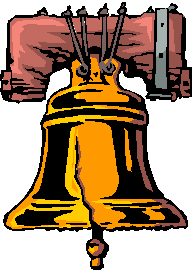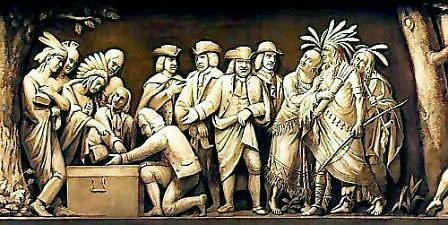

|
|

 2. Grave of Benjamin Franklin in Philadelphia. 2. Grave of Benjamin Franklin in Philadelphia.3. Old Swedes Church (Gloria Dei), Philadelphia, dedicated July 2, 1700; oldest church now standing in Pennsylvania. 4. Battle of Germantown, October 4, 1777. 5. William Penn's House, now in Fairmount Park, Philadelphia. 6. Betsy Ross House, now 239 Arch Street, Philadelphia. General Washington knew her skill with the needle, for she embroidered his shirt ruffles. July, 1776, at the request of Washington, Robert Morris and George Ross, her husband's uncle, she made the first National flag from a rough drawing. 7. Oldest Court House, Philadelphia, in continuous use in the United States. Oldest public building in Pennsylvania and oldest of its kind in the United States. 8. Grave of General Anthony Wayne at Radnor. The hero of Stony Point and the battle of Fallen Timbers died at Presque Isle (Erie), Dec. 15, 1796, and was there buried. In 1809 his remains were removed to Radnor Churchyard. Monument by Society of Cincinnati. 9. Penn's Landing at Chester The Quaker proprietor landed at New Castle, October 27, 1682, from the ship "Welcome." He was received kindly by the Swedes and Dutch and went on to Upland October 29, 1682, soon changing the name to Chester. 10. Benjamin West, world renowned painter, was born at Swarthmore, Delaware County, October 10, 1738. His people were Quakers. He was made "Painter to His Majesty" by King George III. Died in London, March 10, 1820, and is buried in St. Paul's Cathedral. 11. Near Chadd's Ford, Washington's Headquarters, Battle of Brandywine. 12. Kennett Square, the home of Bayard Taylor, Pennsylvania's great writer. 13. Scene of Paoli Massacre. Here Continental troops were surprised by the British, September 20, 1777, even the wounded being bayoneted in the rout. 14. Valley Forge --Washington's Headquarters is now a museum. Valley Forge marks the highest point of sacrifice during the Revolution. 15. Cloister at Ephrata, built for Seventh Day Baptists. Conrad Beissel's settlement, known as the Monastery of Ephrata. First Sabbath School in America. The Cloister is comprised of several buildings dating from 1732 when a Protestant communal society was founded by Conrad Beissel, a German Pietist mystic. 16.Near Millersville, site of Conestoga Indian Village. 17.Robert Fulton Birthplace, Quarryville. The small stone house has been restored and furnished to represent the way it looked at the time of Fulton's birth in 1765. A room in the home contains informative exhibits relating to Fulton's accomplishments as steamship builder, artist, successful inventor and engineer. 17a.Donegal Presbyterian Church and Witness Tree; Mt. Joy. Built around 1730 by Scots-Irish settlers, this church is the site of an important event in the Revolutionary War. In 1777, men of the community joined hands around the white oak, which still stands, to pledge allegiance to their new nation. 17b.Elizabethtown--Here are located the splendid buildings and extensive grounds of the Pennsylvania Masonic homes, covering more than 1000 acres. 18. "Wheatland," the 1828 residence of President James Buchanan, at Lancaster. It is decorated in American Empire and Victorian furnishings. 19. The Grave of Thaddeus Stevens at Lancaster. Stevens saved free school law. Died 1868 and refused to be buried in a cemetery where the color line was drawn. 20. The Indian Treaty of 1711 was made at Lancaster. 21. Cresap Marker. This section of Pennsylvania, near the Maryland border, was the scene of much strife,1731-39. 22. The Centennial Congress met in the Provincial Court House at York, September 30, 1777 to June 27, 1778. The first money sent by the King of France to aid the cause of Independence was received here. The first National Thanksgiving Proclamation was issued from here. 23. The Conway Cabal incidents centered in York. Lafayette at dinner proposed the health of General Washington. Gates and Wilkinson planned a duel but later adjusted their differences. 24. Battle of Hanover (Civil War). On the morning of June 30, 1863, 10,000 men engaged. Kilpatrick and Custer both took part in this fight. 25. July 1, 2, 3, 1863. Gettysburg is the best marked battlefield in the world. The three days' struggle has gone down in history as the "High Water Mark" of the Civil War. Confederate were commanded by Lee and the Northern forces by Meade, a native Pennsylvanian. Battleground covered 6000 acres [national park] or 850 acres [Gettysburg Battlefield Memorial Assoc.]; 84,000 Union Troops and 69,000 Confederate Troops were engaged. The killed, wounded and missing was over 45,000. Lincoln, in his immortal address, dedicated Gettysburg as a National Shrine, November 19, 1863. 26. Chambersburg burned by Confederates in 1864. Lee was in Chambersburg when he made his decision to move toward Gettysburg. 27. Stoney Batter, birthplace of President James Buchanan. Cabin now at Mercersburg Academy. Fort Louden (on Lincoln Highway), named after Lord Louden, who had been commander-in-chief of the English forces in America. 28. Fort Littleton. Governor Robert Hunter Morris ordered a garrison of 75 men to be placed at Fort Littleton, January 29, 1756. 29. Bloody Run, afterwards changed to Everett. Party of traders with 80 horses loaded with goods was surprised by Indians in a narrow defile. After the fight the river was dyed with blood, hence the name. 30. Bedford Springs, a resort and famous spa since before 1823. In the pre-Civil War period many noted politicians visited the springs for the waters and to consult on momentous public questions. |

|
| Frieze by Brumidi, found in the Rotunda of the US Capitol -- "William Penn and the Indians" -- depicting the signing of the Treaty of Shackamoxon between the Quakers and the Delaware (Lenni Lenape) |

|
|
||
|
|
next page | |
|
|
||